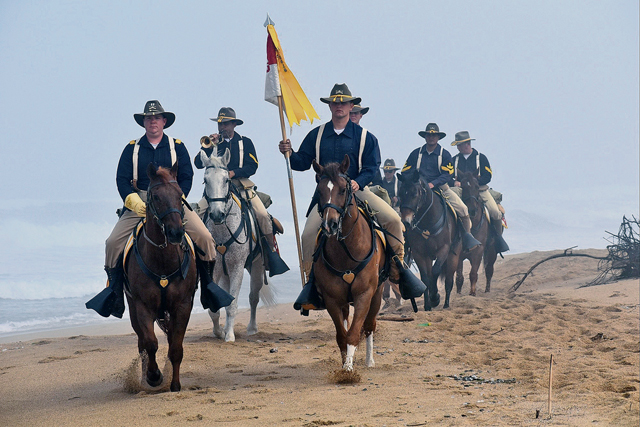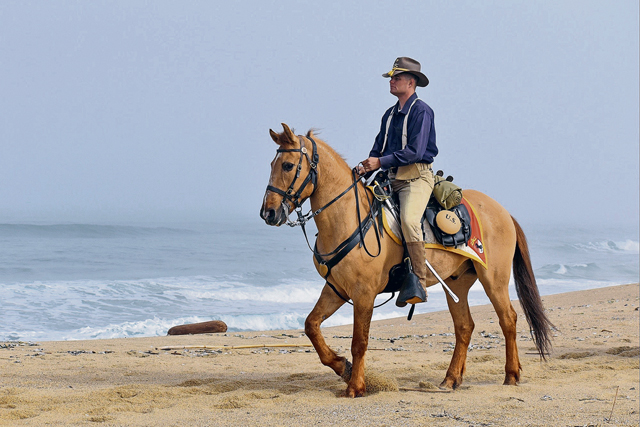
When the 11th Armored Cavalry Regiment “Blackhorse” Horse Detachment visits the Presidio of Monterey, it’s like two longstanding friends getting together for a reunion.
The 11th Cavalry Regiment was stationed at the Presidio from 1919 to 1940, and on Sept. 14, 1924, their shared histories became further united. That was the day lighting struck a 55,000-barrel oil tank in Monterey and ignited a fire so large and destructive that it took days to extinguish. The regiment’s “Blackhorse” moniker and patch emblem refer to the color all the unit’s horses turned that day because of the soot and ash in the air as they helped with firefighting efforts.
Meanwhile, two Soldiers gave their lives fighting the fire: Pvt. George Bolio, assigned to the 11th Cav. Regt., and Pvt. Eustace Watkins, assigned to the 76th Field Artillery Regiment. Leaders named a gate and road after both Soldiers, and the main gate and road into the Presidio still pay tribute to Bolio. Watkins Gate, at the former Fort Ord, no longer exists, but Watkins Gate Road still runs across Fort Ord National Monument. Those associated with the regiment and installation see a remembrance of the fire on a nearly daily basis—whether they know the history or not.
The detachment visits the Presidio nearly annually for the Defense Language Institute Foreign Language Center’s Language Day, an event that features cultural performances and displays. This year, on May 12, members of the detachment presented and retrieved the colors, met with service members, and displayed their riding skills with two demonstrations. They also toured the Presidio of Monterey Museum with a special presentation from Cameron Binkley, command historian for the DLIFLC, on May 11, and took a traditional ride on an area beach on May 13.

Today the unit is stationed at Fort Irwin, California, and Capt. Dave Richards, the detachment’s officer in charge, said members of the detachment have a special appreciation for visiting the Presidio because it helps keep them in touch with their heritage.
“The motto of our horse detachment is ‘Keeping Tradition Alive,’ so this is a really unique trip for us that we do every year because we get to come back here where our actual roots are,” Richards said.
All members of the detachment come from the 11th ACR, and members of the detachment vote to decide who joins after a two-week selection process, Richards said. Members are top performers from all military occupational specialties and do not have to have any experience with horses. It is a temporary assignment that usually lasts between 18 months and two years.
In addition to keeping the tradition alive at as many as 100 community relations events a year, the detachment’s 20 Soldiers and 16 horses train almost exclusively for competitions, Richards said. They have won the U.S. Cavalry Association’s national competition for the past four years consecutively and six times total — the most of any horse Cavalry team throughout the Army.
“We take a lot of pride in being the best regiment and the finest in the land and being those national champions year after year after year,” Richards said.
Richards said the Cavalry horseback riding skills that Soldiers used in the early 1900s are the same skills that the detachment uses today.
“We use the appropriate tack, the appropriate saddles and bridles and bits that were used by the Cavalry in the early 1900s,” Richards said. “They’re all built to specification using manuals from the early 1900s that are still original, period-piece manuals. Everything is as exact and historically accurate as possible.”
That also includes the detachment’s uniforms and guns, Richards said.
Spc. Zachary Carroll has been a member of the detachment for one year and said the experience has changed his life.
“I’ve really found a new passion,” said Carroll, who is an Infantryman by MOS. “I never was a horse person before, but I have a lifelong obsession here. I get to come to work every day and work with this guy [Comanche, the horse]. It’s the best job in the world.”
Cpl. Sarah Alsup, a generator mechanic by MOS, has been a member of the detachment for about six months. She grew up with horses and joining the detachment was one of her main goals when she arrived at Fort Irwin.
In addition to working with horses every day, Alsup said the detachment’s impact on the larger world, as well as its heritage, make her especially proud to be a member.
“Ten [members of the detachment] came out here and we interacted with almost a thousand in a few hours,” Alsup said, referring to Language Day. “That’s a pretty big impact if you stop and think about it.”
Alsup said she appreciated Binkley’s presentation about the unit’s history in Monterey and it helped her gain a deeper understanding of Army tradition.
“Getting to see where your unit has been, is kind of like seeing where your ancestors come from,” Alsup said. “We live by the motto, ‘Keeping Tradition Alive’ every day. We do it all the time. Every day we think about it. We talk about it, but now we actually get to see it, which is really good, because we can talk about things, but until you put them into play or get a real visual of what it is, you never really know. Now we know.”
Binkley said the detachment’s visit is meaningful historically because the Army quartered the 11th Cavalry Regt. at the Presidio between the World Wars. It is also an important part of Monterey’s local history.
“Older residents of Monterey may still recall the days when the mounted Cavalry’s performance team drilled on Soldier Field or at other local venues during public demonstrations of their skills, quite similar to those shown by the detachment during Language Day,” Binkley said.
The regiment has a storied history dating all the way back to its creation in 1901 to support military actions in the Philippines through the Vietnam era until today, where the 11th ACR serves as the opposition force at Fort Irwin’s National Training Center, Binkley said.
The Army created the 11th Cavalry Regt. just a year before the establishment of the Presidio of Monterey, and it created both for the same reason — to support the rise of the United States as a Pacific power, Binkley said.
Richards said it is important to note that while the regiment has switched from horses to mechanized vehicles such as Humvees and Strykers, the basic principles of the Cavalry have not changed.
“The Cavalry has always been that formation that’s out front, scouting, scoping out the enemy, probing lines,” Richards said. “They’re the ones that are setting the conditions for the main fight and they’re gathering as much intelligence as they can for the commander to then decide, ‘This is how I want to go about solving whatever complex problem that is in front of me.’”
The detachment is one of six horse detachments throughout the Army, and while they play a major role in keeping traditions alive, it’s crucial for all Army units to honor their history and traditions, Richards said.
“A lot of Soldiers will tell you the reason they joined the military is for the men and women to their left and to their right that are fighting right beside them,” Richards said. “History is our tie-in to those people who were to the left and to the right of us going all the way back to the founding of the Army and our units.”


